Methylene Blue Removal Using Activated Carbon from Olive Pits: Response Surface Approach and Artificial Neural Network
Abstract
1. Introduction
2. Materials and Methods
2.1. Chemicals
2.2. Preparation and Characterization of Adsorbent
2.3. Adsorption Studies
2.4. Response Surface Method
2.5. Artificial Neural Network
3. Results and Discussion
3.1. Characterization
3.2. Adsorption Isotherms
3.3. Kinetic Studies
3.4. Thermodynamic Studies
3.5. Model Building and Statistical Analysis
3.6. ANN Model
4. Conclusions
Author Contributions
Funding
Data Availability Statement
Conflicts of Interest
References
- Asfaram, A.; Ghaedi, M.; Dashtian, K.; Ghezelbash, G.R. Preparation and characterization of Mn0.4Zn0.6Fe2O4 nanoparticles supported on dead cells of Yarrowia lipolytica as a novel and efficient adsorbent/biosorbent composite for the removal of azo food dyes: Central composite design optimization study. ACS Sustain. Chem. Eng. 2018, 6, 4549–4563. [Google Scholar] [CrossRef]
- Rejeb, Z.B.; Abidli, A.; Zaoui, A.; Fashandi, M.; Selka, A.; Naguib, H.E.; Park, C.B. One-pot synthesis of rationally-designed fexible, robust, and hydrophobic ambient-dried molecularly-bridged silica aerogels with efcient and versatile oil/water separation applications. Adv. Compos. Hybrid Mater. 2024, 7, 188. [Google Scholar] [CrossRef]
- Lee, G.; Ahmed, I.; Lee, H.J.; Jhung, S.H. Adsorptive removal of organic pollutants with a specific functional group from water by using metal–organic frameworks (MOFs) or MOF-derived carbons: A review. Sep. Purif. Technol. 2024, 347, 127602. [Google Scholar] [CrossRef]
- Badeenezhad, A.; Azhdarpoor, A.; Bahrami, S.; Yousefinejad, S. Removal of methylene blue dye from aqueous solutions by natural clinoptilolite and clinoptilolite modified by iron oxide nanoparticles. Mol. Simul. 2019, 45, 564–571. [Google Scholar] [CrossRef]
- Dai, Y.; Zou, J.; Liu, D.; Niu, L.; Zhou, L.; Zhou, Y.; Zhang, X. Preparation of Congo red functionalized Fe3O4@SiO2 nanoparticle and its application for the removal of methylene blue. Colloids Surf. A Physicochem. Eng. Asp. 2018, 550, 90–98. [Google Scholar]
- Farghali, M.A.; Abo-Aly, M.M.; Salaheldin, T.A. Modified mesoporous zeolite-A/reduced graphene oxide nanocomposite for dual removal of methylene blue and Pb2+ ions from wastewater. Inorg. Chem. Commun. 2021, 126, 108487. [Google Scholar] [CrossRef]
- Hosseini, H.; Pirahmadi, P.; Shakeri, S.E.; Khoshbakhti, E.; Sharafkhani, S.; Fakhri, V.; Saeidi, A.; McClements, D.J.; Chen, W.-H.; Su, C.-H.; et al. A novel environmentally friendly nanocomposite aerogel based on the semi-interpenetrating network of polyacrylic acid into Xanthan gum containing hydroxyapatite for efficient removal of methylene blue from wastewater. Int. J. Biol. Macromol. 2022, 201, 133–142. [Google Scholar] [CrossRef]
- Mosleh, S.; Rahimi, M.R.; Ghaedi, M.; Dashtian, K.; Hajati, S.; Wang, S. Ag3PO4/AgBr/Ag-HKUST-1-MOF composites as novel blue LED light active photocatalyst for enhanced degradation of ternary mixture of dyes in a rotating packed bed reactor. Chem. Eng. Process. Process Intensif. 2017, 114, 24–38. [Google Scholar] [CrossRef]
- Chen, M.; Yang, H.; Xu, Z.L.; Cheng, C. Separation of single and mixed anionic dyes in saline solutions using uncharged polyacrylonitrile-tris (hydroxymethyl) aminomethane (PAN-Tris) ultrafiltration membrane: Performance and mechanism. J. Clean. Prod. 2022, 336, 130471. [Google Scholar] [CrossRef]
- Nnaji, P.C.; Anadebe, V.C.; Ezemagu, I.G.; Onukwuli, O.D. Potential of Luffa cylindrica seed as coagulation-flocculation (CF) agent for the treatment of dye wastewater: Kinetic, mass transfer, optimization and CF adsorption studies. Arab. J. Chem. 2022, 15, 103629. [Google Scholar] [CrossRef]
- Sayin, F. Insight into decolorization characteristics of a green biocomposite sorbent system prepared by immobilization of fungal cells on lignocellulosic matrix: Box-behnken design. Water Air Soil Pollut. 2022, 233, 262. [Google Scholar] [CrossRef]
- Sánchez-Albores, R.; Cano, F.J.; Sebastian, P.J.; Reyes-Vallejo, O. Microwave-assisted biosynthesis of ZnO-GO particles using orange peel extract for photocatalytic degradation of methylene blue. J. Environ. Chem. Eng. 2022, 10, 108924. [Google Scholar] [CrossRef]
- Singh, A.L.; Chaudhary, S.; Kumar, S.; Kumar, A.; Singh, A.; Yadav, A. Biodegradation of Reactive Yellow-145 azo dye using bacterial consortium: A deterministic analysis based on degradable Metabolite, phytotoxicity and genotoxicity study. Chemosphere 2022, 300, 134504. [Google Scholar] [CrossRef]
- Pormazar, S.M.; Dalvand, A. Adsorption of Reactive Black 5 azo dye from aqueous solution by using amine-functioned Fe3O4 nanoparticles with L-arginine: Process optimisation using RSM. Int. J. Environ. Anal. Chem. 2022, 102, 1764–1783. [Google Scholar] [CrossRef]
- Ahmed, M.J. Application of agricultural based activated carbons by microwave and conventional activations for basic dye adsorption: Review. J. Environ. Chem. Eng. 2016, 4, 89–99. [Google Scholar] [CrossRef]
- Azari, A.; Nabizadeh, R.; Nasseri, S.; Mahvi, A.H.; Mesdaghinia, A.R. Comprehensive systematic review and meta-analysis of dyes adsorption by carbon-based adsorbent materials: Classification and analysis of last decade studies. Chemosphere 2020, 250, 126238. [Google Scholar] [CrossRef]
- Limousy, L.; Ghouma, I.; Ouederni, A.; Jeguirim, M. Amoxicillin removal from aqueous solution using activated carbon prepared by chemical activation of olive stone. Environ. Sci. Pollut. Res. 2017, 24, 9993–10004. [Google Scholar] [CrossRef]
- Sinha, K.; Saha, P.D.; Datta, S. Response surface optimization and artificial neural network modelling of microwave assisted natural dye extraction from pomegranate rind. Ind. Crops Prod. 2012, 37, 408–414. [Google Scholar] [CrossRef]
- Barbanera, M.; Lascaro, E.; Foschini, D.; Cotana, F.; Buratti, C. Optimization of bioethanol production from steam exploded hornbeam wood (Ostrya carpinifolia) by enzymatic hydrolysis. Renew. Energy 2018, 124, 136–143. [Google Scholar] [CrossRef]
- Shojaeimehr, T.; Rahimpour, F.; Khadivi, M.A.; Sadeghi, M. A modelling study by response surface methodology (RSM) and artificial neural network (ANN) on Cu2+ adsorption optimization using light expended clay aggregate (LECA). J. Ind. Eng. Chem. 2014, 20, 870–880. [Google Scholar] [CrossRef]
- Bagheri, R.; Ghaedi, M.; Asfaram, A.; Dil, E.A.; Javadian, H. RSM-CCD design of malachite green adsorption onto activated carbon with multimodal pore size distribution prepared from Amygdalus scoparia: Kinetic and isotherm studies. Polyhedron 2019, 171, 464–472. [Google Scholar] [CrossRef]
- Singh, A.; Bishnoi, N.R. Enzymatic hydrolysis optimization of microwave alkali pretreated wheat straw and ethanol production by yeast. Bioresour. Technol. 2012, 108, 94–101. [Google Scholar] [CrossRef]
- Prabu, D.; Parthiban, R.; Narendrakumar, G. Application of response surface methodology for removal of Congo red dye by nanozerovalent iron impregnated cashew nutshell. J. Chem. Pharm. Res. 2015, 7, 879–884. [Google Scholar]
- Danda, S.K.; Ramachandramurthy, C.V.; Dayana, K.; Sowjanya, C.V. Application of response surface methodology (RSM) for the removal of nickel using rice husk ash as biosorbent. Int. J. Eng. Res. Generic Sci. 2014, 2, 162–176. [Google Scholar]
- Dhiman, N.; Singh, A.; Verma, N.K.; Ajaria, N.; Patnaik, S. Statistical optimization and artificial neural networkmodeling for acridine orange dye degradation using in-situ synthesized polymer capped ZnO nanoparticles. J. Colloid Interface Sci. 2017, 493, 295–300. [Google Scholar] [CrossRef]
- Igwegbe, C.A.; Mohmmadi, L.; Ahmadi, S.; Rahdar, A.; Khadkhodaiy, D.; Dehghani, R.; Rahdar, S. Modeling of adsorption of methylene blue dye on Ho-CaWO4 nanoparticles using response surface methodology (RSM) and artificial neural network (ANN) techniques. MethodsX 2019, 6, 1779–1797. [Google Scholar] [CrossRef]
- Onu, C.E.; Nwabanne, J.T.; Ohale, P.E.; Asadu, O. Comparative analysis of RSM, ANN and ANFIS and the mechanistic modeling in eriochrome black-T dye adsorption using modified clay. S. Afr. J. Chem. Eng. 2021, 36, 24–42. [Google Scholar] [CrossRef]
- Dil, E.A.; Ghaedi, M.; Asfaram, A.; Mehrabi, F.; Bazrafshan, A.A.; Ghaedi, A.M. Trace determination of safranin O dye using ultrasound assisted dispersive solidphase micro extraction: Artificial neural network-genetic algorithm and response surface methodology. Ultrason. Sonochem. 2016, 33, 129–140. [Google Scholar] [CrossRef] [PubMed]
- Karri, R.R.; Sahu, J.N. Modeling and optimization by particle swarm embedded neural network for adsorption of zinc (II) by palm kernel shell based activated carbon from aqueous environment. J. Environ. Manag. 2018, 206, 178–191. [Google Scholar] [CrossRef]
- Lingamdinne, L.P.; Singh, J.; Choi, J.; Chang, Y.; Yang, J.; Karri, R.R.; Koduru, J.R. Multivariate modeling via artificial neural network applied to enhance methylene blue sorption using graphene-like carbon material prepared from edible sugar. J. Mol. Liq. 2018, 265, 416–427. [Google Scholar] [CrossRef]
- Buledi, J.A.; Pato, A.H.; Kanhar, A.H.; Solangi, A.R.; Batool, M.; Ameen, S.; Palabiyik, I.M. Heterogeneous kinetics of CuO nanoflakes in simultaneous decolorization of Eosin Y and Rhodamine B in aqueous media. Appl. Nanosci. 2021, 11, 1241–1256. [Google Scholar] [CrossRef]
- Kumar, M.R.; King, P.; Wolde, Z.; Mulu, M. Application of optimization response surface for the biosorption of crystal violet dye from textile wastewater onto Clerodendrum fragrans leaves. Biomass Convers. Biorefinery 2022, 13, 17133–17148. [Google Scholar] [CrossRef]
- Kumari, S.; Verma, A.; Sharma, P.; Agarwal, S.; Rajput, V.D.; Minkina, T.; Rajput, P.; Singh, S.P.; Garg, M.C. Introducing machine learning model to response surface methodology for biosorption of methylene blue dye using Triticum aestivum biomass. Sci. Rep. 2023, 13, 8574. [Google Scholar] [CrossRef]
- Prasad, R.; Yadav, K.D. Use of Response Surface Methodology And Artificial Neural Network Approach For Methylene Blue Removal By Adsorption Onto Water Hyacinth. Water Conserv. Manag. WCM 2020, 4, 83–89. [Google Scholar] [CrossRef]
- Muhammad, N.; Manurung, Y.H.; Jaafar, R.; Abas, S.K.; Tham, G.; Haruman, E. Model development for quality features of resistance spot welding using multi-objective Taguchi method and response surface methodology. J. Intell. Manuf. 2013, 24, 1175–1183. [Google Scholar] [CrossRef]
- Pato, A.H.; Balouch, A.; Talpur, F.N.; Abdullah; Panah, P.; Mahar, A.M.; Jagirani, M.S.; Kumar, S.; Sanam, S. Fabrication of TiO2@ITO-grown nanocatalyst as efficient applicant for catalytic reduction of Eosin Y from aqueous media. Environ. Sci. Pollut. Res. 2021, 28, 947–959. [Google Scholar] [CrossRef] [PubMed]
- Alardhi, S.M.; Fiyadh, S.S.; Salman, A.D.; Adelikhah, M. Prediction of methyl orange dye (MO) adsorption using activated carbon with an artificial neural network optimization modeling. Heliyon 2023, 9, e12888. [Google Scholar] [CrossRef] [PubMed]
- Rene, E.R.; Veiga, M.C.; Kennes, C. Experimental and neural model analysis of styrene removal from polluted air in a biofilter. J. Chem. Technol. Biotechnol. 2009, 84, 941–948. [Google Scholar] [CrossRef]
- Tamjidi, S.; Esmaeili, H.; Moghadas, B.K. Application of magnetic adsorbents for removal of heavy metals from wastewater: A review study. Mater. Res. Express 2019, 6, 102004. [Google Scholar] [CrossRef]
- Pan, D.; Chen, H. Border pollution reduction in China: The role of livestock environmental regulations. China Econ. Rev. 2021, 69, 101681. [Google Scholar] [CrossRef]
- Ahmadi, A.; Foroutan, R.; Esmaeili, H.; Tamjidi, S. The role of bentonite clay and bentonite clay@MnFe2O4 composite and their physico-chemical properties on the removal of Cr(III) and Cr(VI) from aqueous media. Environ. Sci. Pollut. Res. 2020, 27, 14044–14057. [Google Scholar] [CrossRef]
- Abdel-GhANi, N.T.; El-Chaghaby, G.A.; Rawash, E.S.A.; Lima, E.C. Adsorption of coomassie brilliant blue r-250 dye onto novel activated carbon prepared from Nigella sativa L. waste: Equilibrium, kinetics and thermodynamics running title: Adsorption of brilliant blue dye onto Nigella sativa L. waste activated carbon. J. Chil. Chem. Soc. 2017, 62, 3505–3511. [Google Scholar] [CrossRef]
- Thang, H.N.; Sy Khang, D.; Duy, H.T.; Thi, N.D.; Dinh, T.P. Methylene blue adsorption mechanism of activated carbon synthesized from cashew nut shells. RSC Adv. 2021, 11, 26563–26570. [Google Scholar] [CrossRef] [PubMed]
- Jabar, J.M.; Odusote, Y.A.; Ayinde, Y.T.; Yılmaz, M. African almond (Terminalia catappa L.) leaves biochar prepared through pyrolysis using H3PO4 as chemical activator for sequestration of methylene blue dye. Results Eng. 2022, 14, 100385. [Google Scholar] [CrossRef]
- Yousef, T.A.; Sahu, U.K.; Jawad, A.H.; Abd Malek, N.N.; Al Duaij, O.K.; ALOthman Zeid, A. Fruit peel-based mesoporous activated carbon via microwave assisted K2CO3 activation: Box Behnken design and desirability function for methylene blue dye adsorption. Int. J. Phytoremediation 2023, 25, 1142–1154. [Google Scholar] [CrossRef] [PubMed]
- Yagmur, H.K.; Kaya, I. Synthesis and characterization of magnetic ZnCl2-activated carbon produced from coconut shell for the adsorption of methylene blue. J. Mol. Struct. 2021, 1232, 130071. [Google Scholar] [CrossRef]
- Ma, Y. Comparison of Activated Carbons Prepared from Wheat Straw via ZnCl2 and KOH Activation. Waste Biomass Valorization 2017, 8, 549–559. [Google Scholar] [CrossRef]
- Zahari, K.F.A.; Sahu, U.K.; Khadiran, T.; Surip, S.N.; ALOthman Zeid, A.; Jawad, A.H. Mesoporous Activated Carbon from Bamboo Waste via Microwave-Assisted K2CO3 Activation: Adsorption Optimization and Mechanism for Methylene Blue Dye. Separations 2022, 9, 390. [Google Scholar] [CrossRef]
- Sarici, B.; Karataş, Ş.; Altintig, E. Removal of Methylene blue from aqueous solution with activated carbon produced from hazelnut shells by K2CO3 activation. Desalination Water Treat. 2022, 254, 287–301. [Google Scholar] [CrossRef]
- El-Mekkawi, D.; Galal, H.R. Removal of a synthetic dye “Direct Fast Blue B2RL” via adsorption and photocatalytic degradation using low-cost rutile and Degussa P25 titanium dioxide. J. Hydro-Environ. Res. 2013, 7, 219–226. [Google Scholar] [CrossRef]
- Yagub, M.T.; Sen, T.K.; Afroze, S.; Ang, H.M. Dye and its removal from aqueous solution by adsorption: A review. Adv. Colloid Interface Sci. 2014, 209, 172–184. [Google Scholar] [CrossRef]
- Salleh, M.A.M.; Mahmoud, D.K.; Karim, W.A.W.A.; Idris, A. Cationic and anionic dye adsorption by agricultural solid wastes: A comprehensive review. Desalination 2011, 280, 1–13. [Google Scholar] [CrossRef]
- Ali, I.; Asim, M.; Khan, T.A. Low cost adsorbents for the removal of organic pollutants from wastewater. J. Environ. Manag. 2012, 113, 170–183. [Google Scholar] [CrossRef]
- Gupta, V.K.; Kumar, R.; Nayak, A.; Saleh, T.A.; Barakat, M.A. Adsorptive removal of dyes from aqueous solution onto carbon nanotubes: A review. Adv. Colloid Interface Sci. 2013, 193, 24–34. [Google Scholar] [CrossRef]
- Mahmoodi, N.M. Photodegradation of dyes using multiwalled carbon nanotube and ferrous ion. J. Environ. Eng. 2013, 139, 1368–1374. [Google Scholar] [CrossRef]

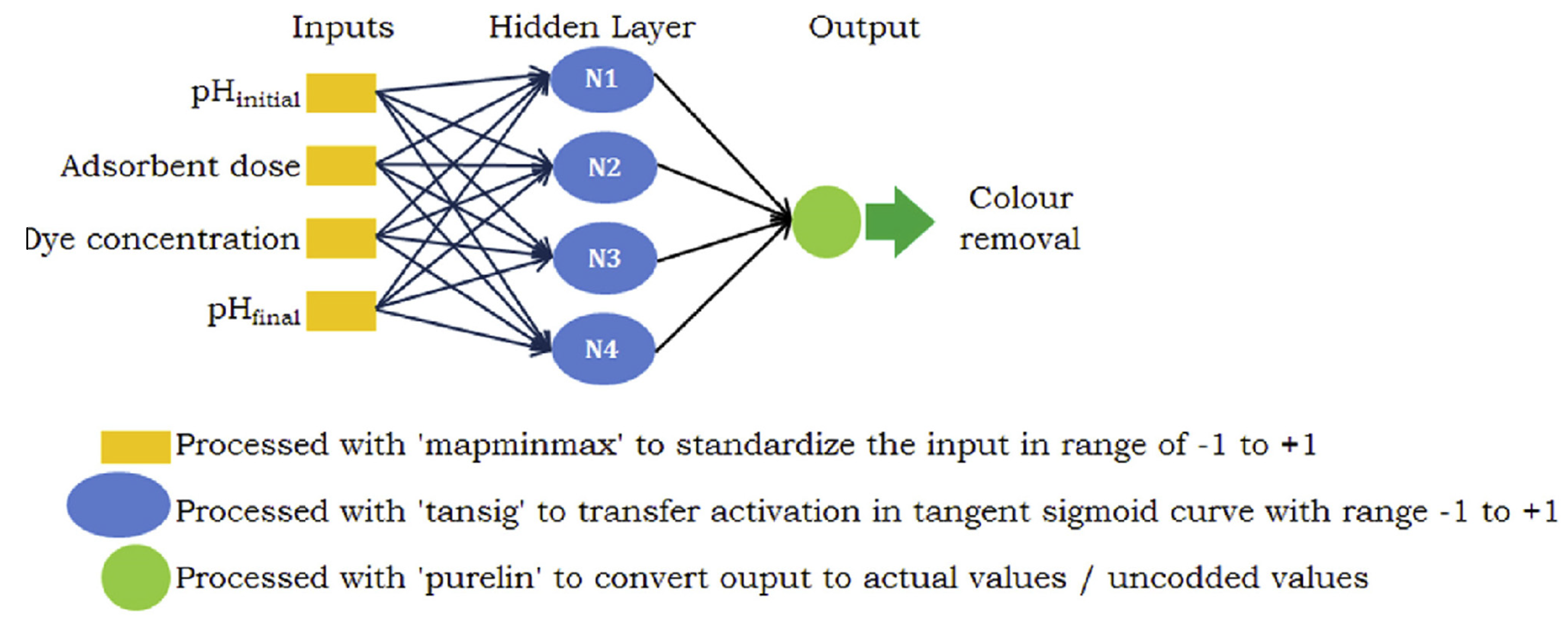
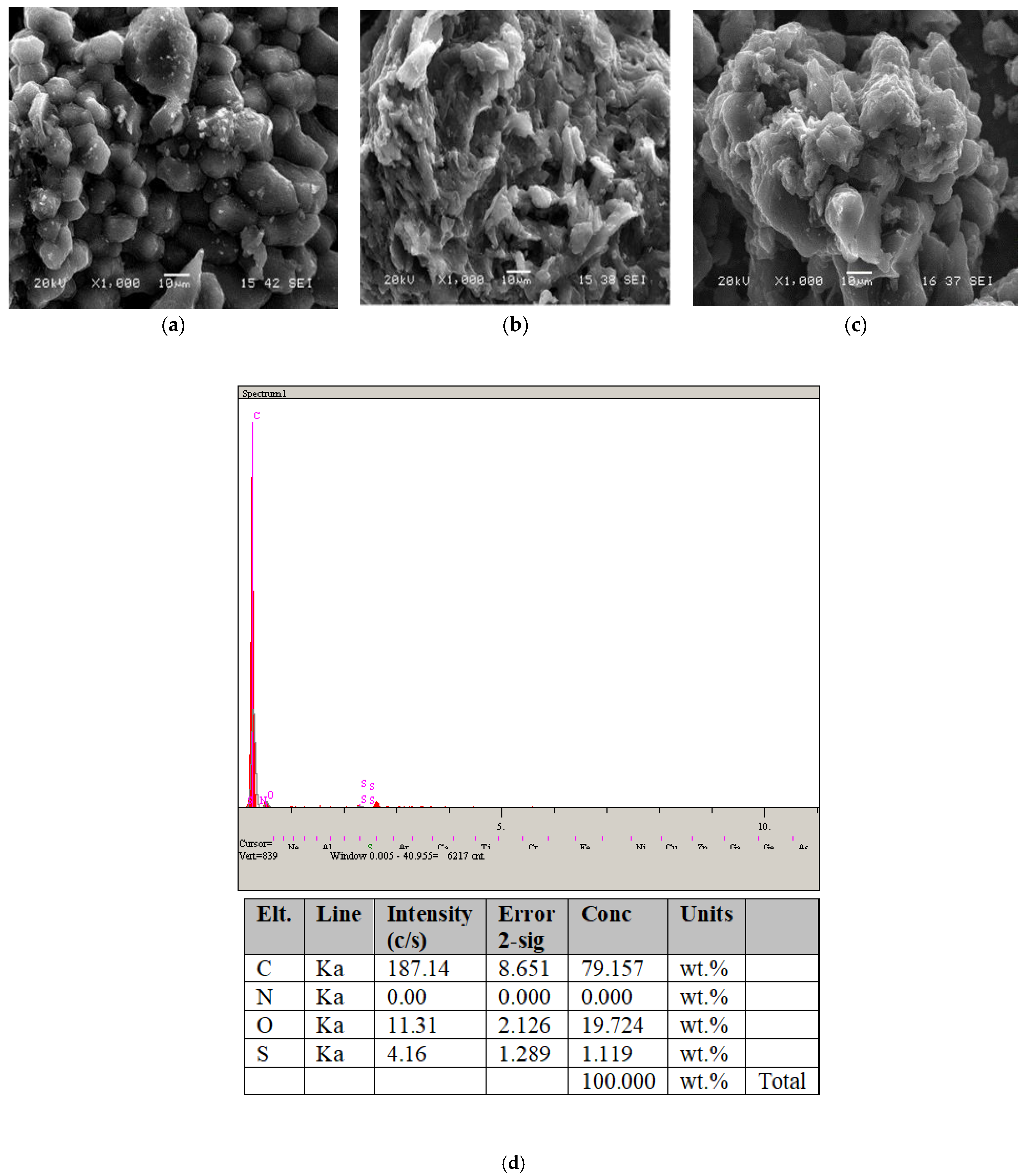
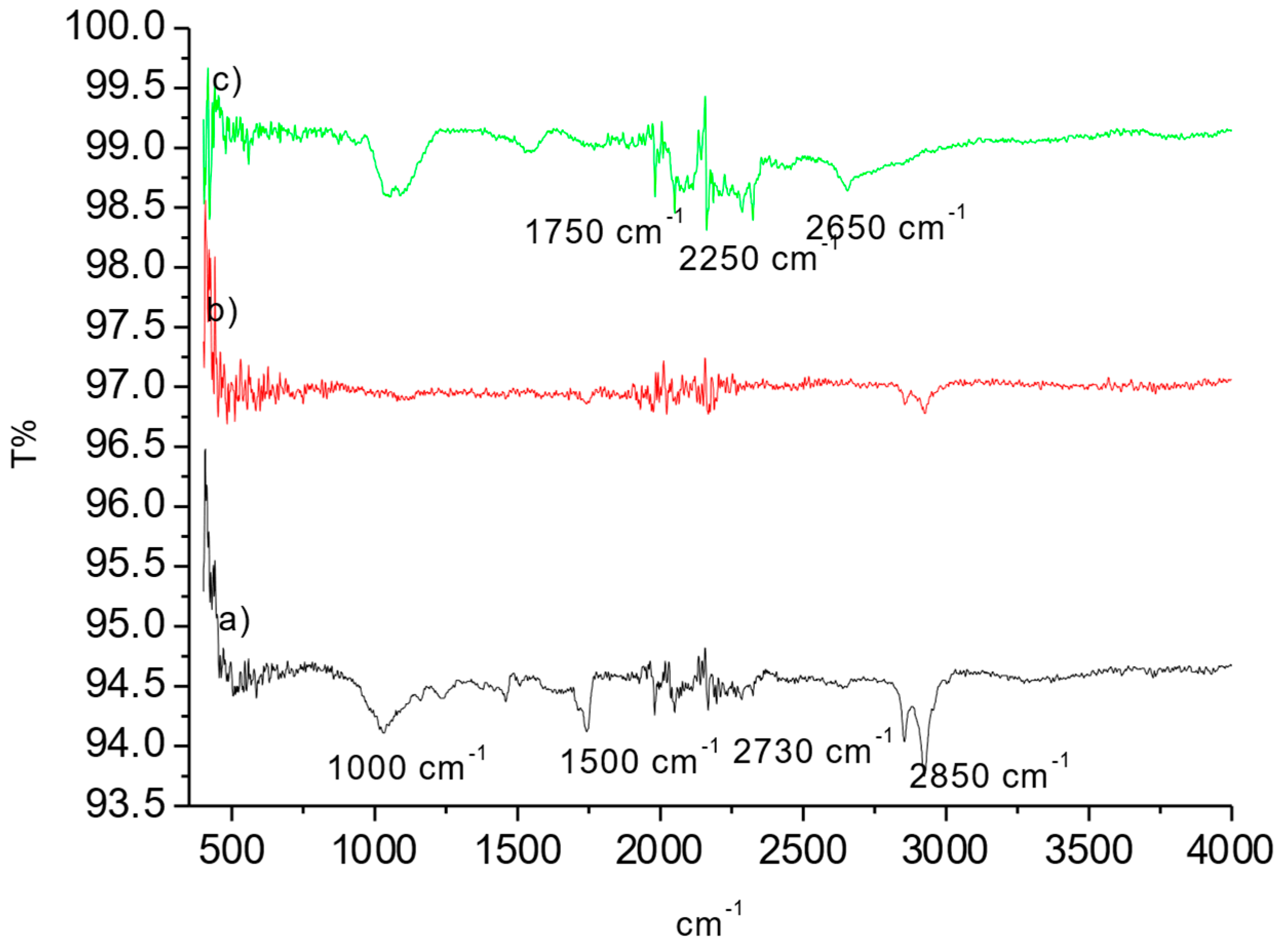




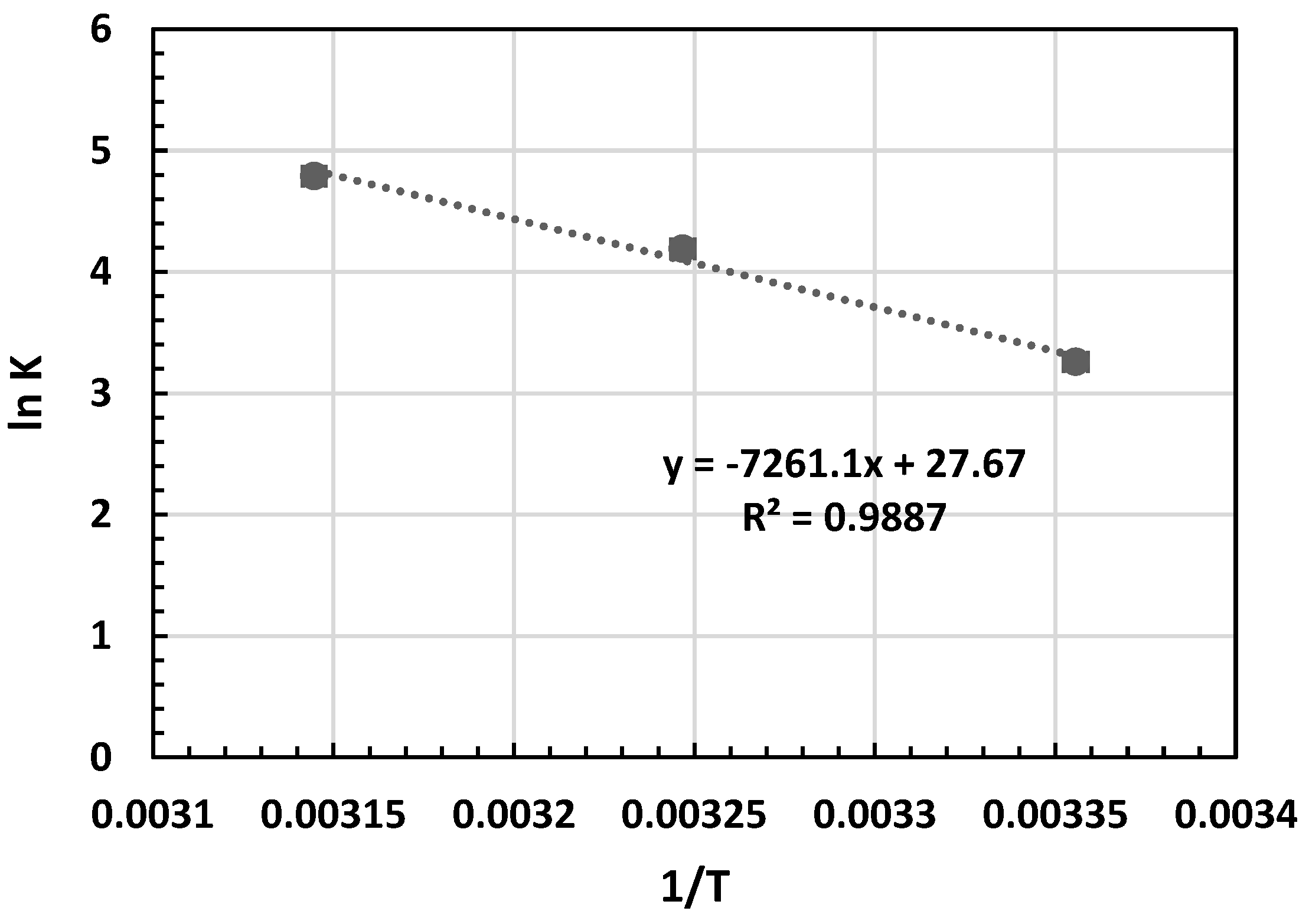
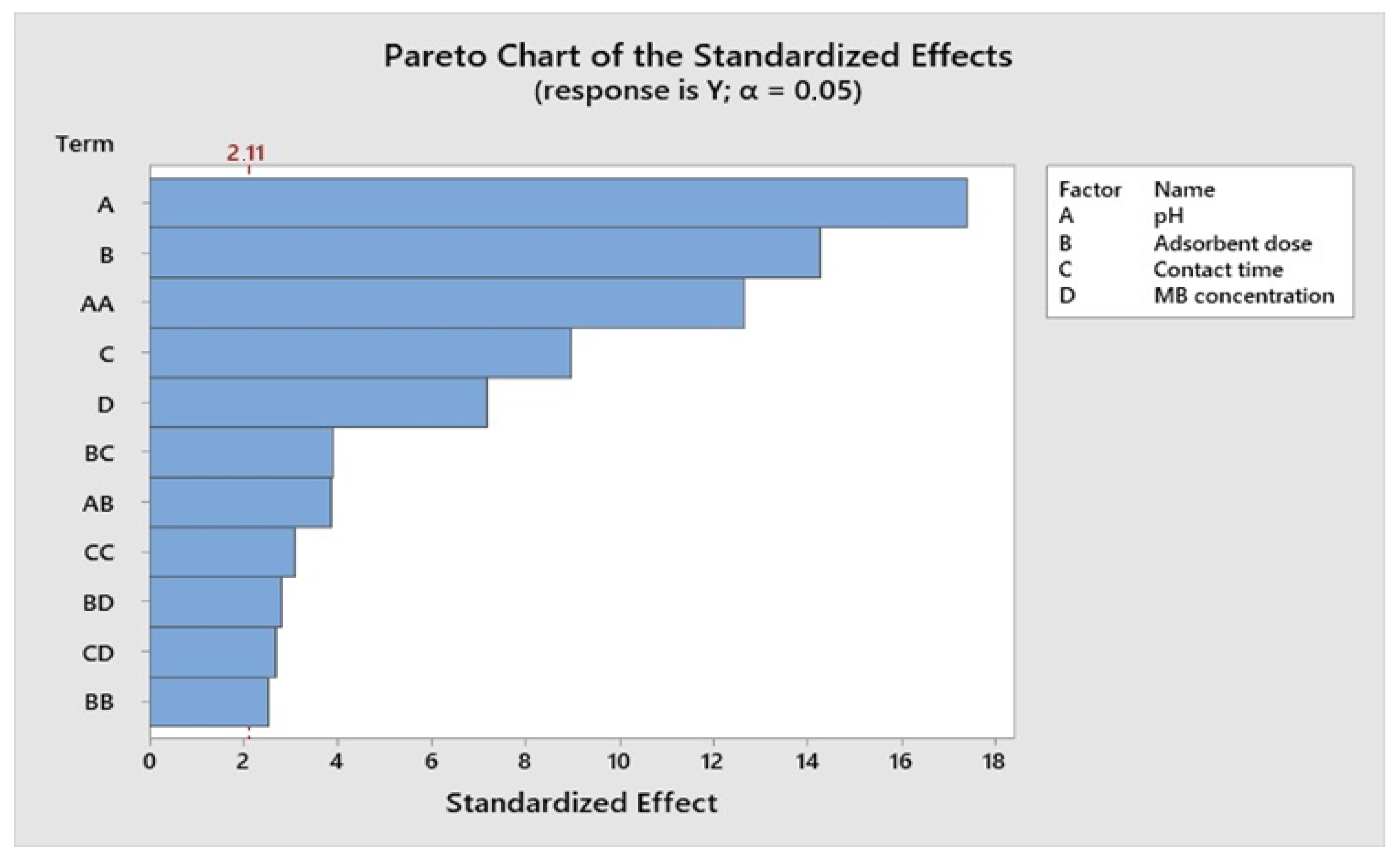
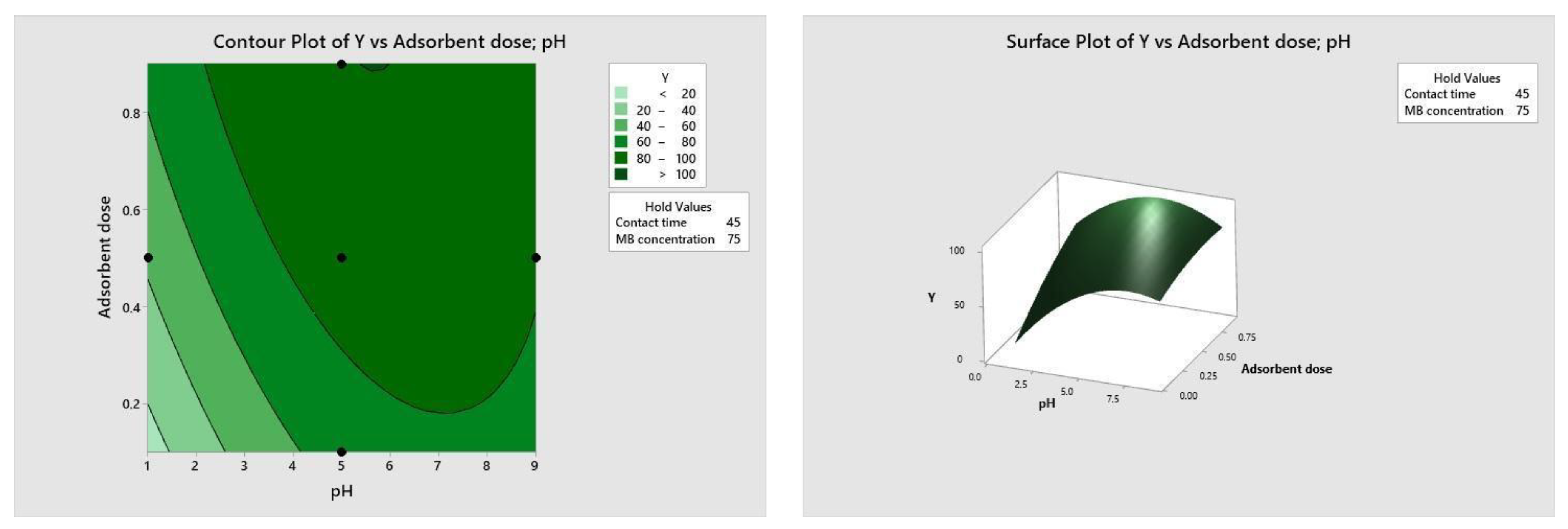



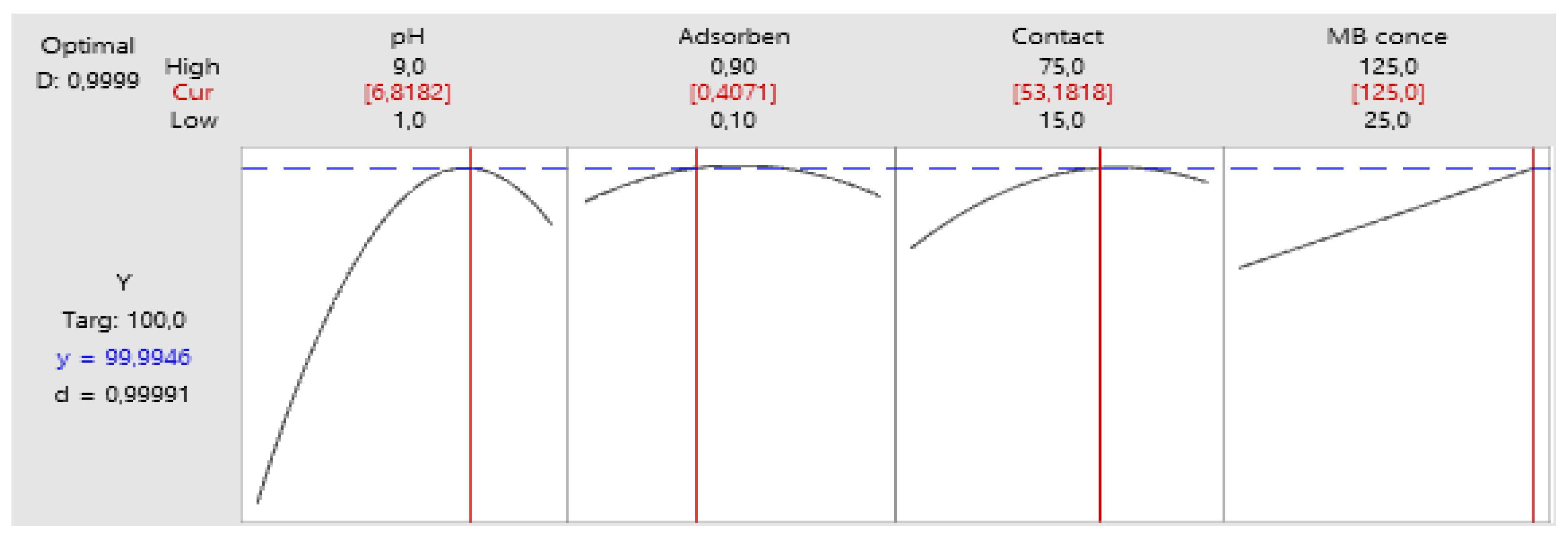


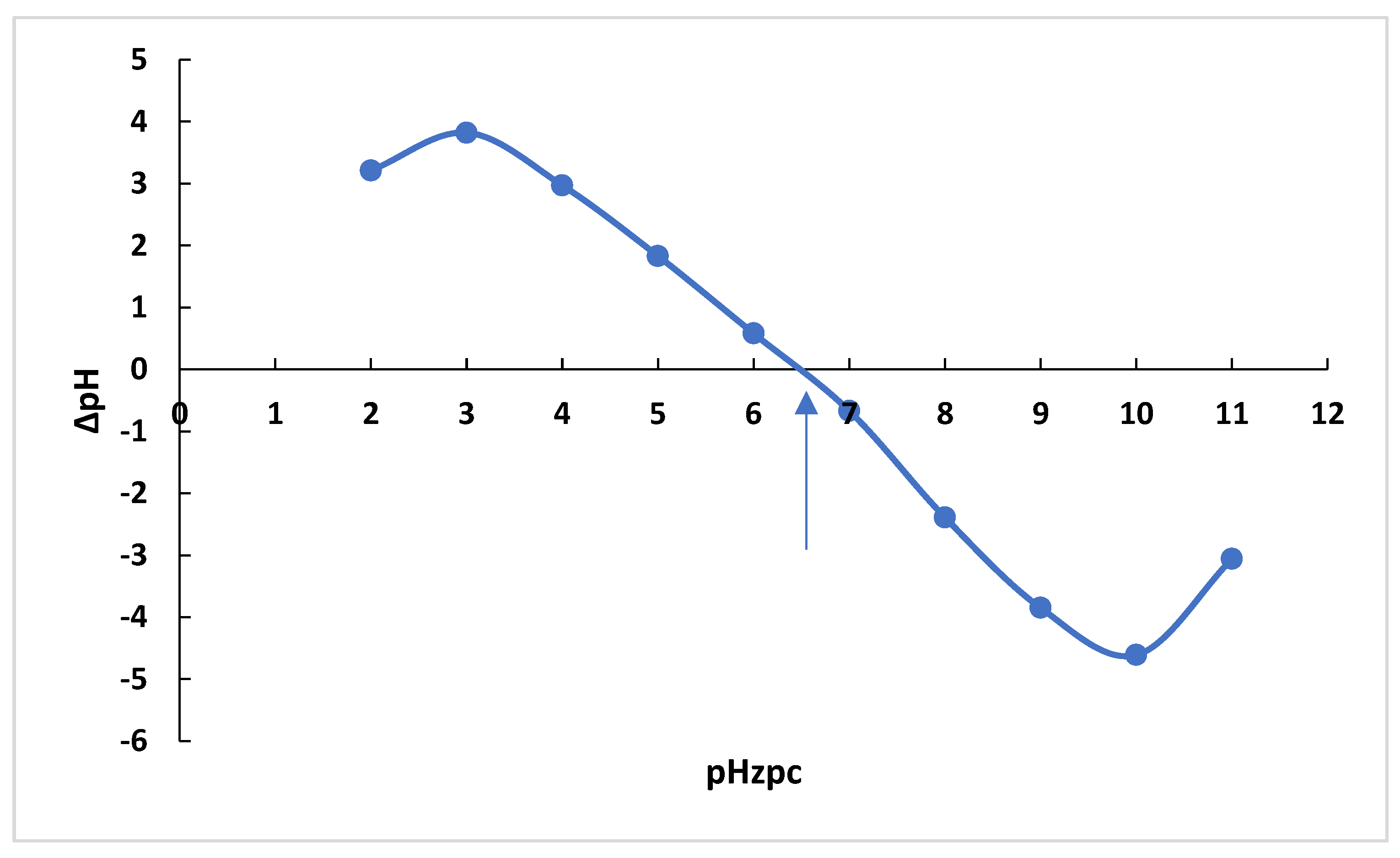
| Factors | Lowest (−2) | Lower (−1) | Middle (0) | Higher (+1) | Highest (+2) |
|---|---|---|---|---|---|
| pH | 1 | 3 | 5 | 7 | 9 |
| Dosage (g/100 mL) | 0.1 | 0.3 | 0.5 | 0.7 | 0.9 |
| Time (min) | 15 | 30 | 45 | 60 | 75 |
| Concentration (mg/L) | 25 | 50 | 75 | 100 | 125 |
| Experiment No. | Factor 1 : pH | Factor 2 : Dose (g/100 mL) | Factor 3 : Time (min) | Factor 4 : Concentration (mg/L) | % Y (MB) |
|---|---|---|---|---|---|
| 1 | 3 | 0.3 | 30 | 50 | 42.15 |
| 2 | 7 | 0.3 | 30 | 50 | 67.24 |
| 3 | 3 | 0.7 | 30 | 50 | 73.67 |
| 4 | 7 | 0.7 | 30 | 50 | 89.72 |
| 5 | 3 | 0.3 | 60 | 50 | 64.20 |
| 6 | 7 | 0.3 | 60 | 50 | 90.17 |
| 7 | 3 | 0.7 | 60 | 50 | 83.45 |
| 8 | 7 | 0.7 | 60 | 50 | 97.18 |
| 9 | 3 | 0.3 | 30 | 100 | 60.11 |
| 10 | 7 | 0.3 | 30 | 100 | 86.24 |
| 11 | 3 | 0.7 | 30 | 100 | 83.15 |
| 12 | 7 | 0.7 | 30 | 100 | 95.39 |
| 13 | 3 | 0.3 | 60 | 100 | 75.90 |
| 14 | 7 | 0.3 | 60 | 100 | 94.27 |
| 15 | 3 | 0.7 | 60 | 100 | 88.14 |
| 16 | 7 | 0.7 | 60 | 100 | 99.16 |
| 17 | 5 | 0.5 | 45 | 75 | 87.43 |
| 18 | 5 | 0.5 | 45 | 75 | 88.20 |
| 19 | 5 | 0.5 | 45 | 75 | 93.38 |
| 20 | 5 | 0.5 | 45 | 75 | 89.34 |
| 21 | 1 | 0.5 | 45 | 75 | 39.58 |
| 22 | 9 | 0.5 | 45 | 75 | 82.14 |
| 23 | 5 | 0.1 | 45 | 75 | 66.28 |
| 24 | 5 | 0.9 | 45 | 75 | 97.43 |
| 25 | 5 | 0.5 | 15 | 75 | 74.16 |
| 26 | 5 | 0.5 | 75 | 75 | 87.13 |
| 27 | 5 | 0.5 | 45 | 25 | 82.18 |
| 28 | 5 | 0.5 | 45 | 125 | 93.24 |
| 29 | 5 | 0.5 | 45 | 75 | 87.46 |
| 30 | 5 | 0.5 | 45 | 75 | 87.64 |
| Sample | SBET (m2 g−1) | t-Plot Micropore Volume (cm3 g−1) | Average Pore Width (nm) |
|---|---|---|---|
| OP | 113.0276 | 0.180297 | 2.687 |
| OPAC | 796.5884 | 0.307852 | 2.489 |
| Langmuir Isotherm | Freundlich Isotherm | ||||
|---|---|---|---|---|---|
| Qm (mg/g) | KL (L/mg) | R2 | KF | n (L/mg) | R2 |
| 312.5 | 0.16 | 0.99 | 72.65 | 2.99 | 0.75 |
| C0 (mg L−1) | Pseudo 1st Order | Pseudo 2nd Order | |||||
|---|---|---|---|---|---|---|---|
| qeexp | k1,min−1 | qecal (mg g−1) | R2 | k2 (g.mg−1.min−1) | qecal (mg g−1) | R2 | |
| 50 | 49.50 | 0.045 | 32.41 | 0.84 | 0.089 | 55.86 | 0.99 |
| 100 | 99.01 | 0.048 | 52.40 | 0.95 | 0.17 | 105.26 | 0.99 |
| 150 | 147.76 | 0.057 | 87.55 | 0.71 | 0.27 | 151.52 | 0.99 |
| T (K) | ΔG° (kJ/mol) | ΔH° (kJ/mol) | ΔS° (J/mol) |
|---|---|---|---|
| 293 | −7.93 | 59.38 | |
| 303 | −10.55 | 0.23 | |
| 313 | −12.46 |
| Adsorbent | SBET (m2 g−1) | pH | Temperature (K) | Time (min) | MB Concentration mg/L | Adsorption Capacity (mg g−1) | References |
|---|---|---|---|---|---|---|---|
| Cashew nutshells | 679 | 9 | 300 | 80 | 230 | [43] | |
| Almond leaves | 816 | 8 | 303 | 30 | 50 | 264 | [44] |
| Fruit peel | 525.92 | 8.4 | 312 | 3 | 50 | 312.8 | [45] |
| Coconut shell | 935.46 | 4.9 | 298–318 | 0–360 | 25–500 | 156.0 | [46] |
| Wheat straw | 907 | 7 | 303 | 90 | 5 | 265.96 | [47] |
| Bamboo waste | 107.148 | 7.62 | 298 | 8 | 50 | 85.6 | [48] |
| Hazelnut Shells | 472 | 8 | 293 | 120 | 50–250 | 303.03 | [49] |
| OPAC | 796.5884 | 298 | 100 | 312.05 | This Study |
| Source | DF | Seq SS | Adj SS | Adj MS | F-Value | p-Value |
|---|---|---|---|---|---|---|
| Model | 12 | 6425.48 | 6425.48 | 535.46 | 71.02 | 0.000 |
| Blocks | 1 | 48.62 | 48.62 | 48.62 | 6.45 | 0.021 |
| Linear | 4 | 4807.17 | 4807.17 | 1201.79 | 159.39 | 0.000 |
| 1 | 2276.04 | 2276.04 | 2276.04 | 301.87 | 0.000 | |
| 1 | 1534.08 | 1534.08 | 1534.08 | 203.46 | 0.000 | |
| 1 | 607.42 | 607.42 | 607.42 | 80.56 | 0.000 | |
| 1 | 389.62 | 389.62 | 389.62 | 51.67 | 0.000 | |
| Square | 3 | 1227.46 | 1227.46 | 409.15 | 54.27 | 0.000 |
| 1 | 1119.56 | 1204.88 | 1204.88 | 159.8 | 0.000 | |
| 1 | 35.01 | 48.13 | 48.13 | 6.38 | 0.022 | |
| 1 | 72.9 | 72.9 | 72.9 | 9.67 | 0.006 | |
| 2-Way Interaction | 4 | 342.23 | 342.23 | 85.56 | 11.35 | 0.000 |
| 1 | 113 | 113 | 113 | 14.99 | 0.001 | |
| 1 | 114.49 | 114.49 | 114.49 | 15.18 | 0.001 | |
| 1 | 59.83 | 59.83 | 59.83 | 7.94 | 0.012 | |
| 1 | 54.91 | 54.91 | 54.91 | 7.28 | 0.015 | |
| Error | 17 | 128.18 | 128.18 | 7.54 | ||
| Lack of Fit | 13 | 107.14 | 107.14 | 8.24 | 1.57 | 0.356 |
| Pure Error | 4 | 21.04 | 21.04 | 5.26 | ||
| Total | 29 | 6553.65 |
| Factors | pH | Dose (g/100 mL) | Time (min) | Concentration (mg/L) | %Removal |
|---|---|---|---|---|---|
| Values | 6.1940 | 0.7461 | 50.1528 | 75 | 100 |
Disclaimer/Publisher’s Note: The statements, opinions and data contained in all publications are solely those of the individual author(s) and contributor(s) and not of MDPI and/or the editor(s). MDPI and/or the editor(s) disclaim responsibility for any injury to people or property resulting from any ideas, methods, instructions or products referred to in the content. |
© 2025 by the authors. Licensee MDPI, Basel, Switzerland. This article is an open access article distributed under the terms and conditions of the Creative Commons Attribution (CC BY) license (https://creativecommons.org/licenses/by/4.0/).
Share and Cite
Ozcelik, T.O.; Altintig, E.; Cetinkaya, M.; Ak, D.B.; Sarici, B.; Ates, A. Methylene Blue Removal Using Activated Carbon from Olive Pits: Response Surface Approach and Artificial Neural Network. Processes 2025, 13, 347. https://doi.org/10.3390/pr13020347
Ozcelik TO, Altintig E, Cetinkaya M, Ak DB, Sarici B, Ates A. Methylene Blue Removal Using Activated Carbon from Olive Pits: Response Surface Approach and Artificial Neural Network. Processes. 2025; 13(2):347. https://doi.org/10.3390/pr13020347
Chicago/Turabian StyleOzcelik, Tijen Over, Esra Altintig, Mehmet Cetinkaya, Dilay Bozdag Ak, Birsen Sarici, and Asude Ates. 2025. "Methylene Blue Removal Using Activated Carbon from Olive Pits: Response Surface Approach and Artificial Neural Network" Processes 13, no. 2: 347. https://doi.org/10.3390/pr13020347
APA StyleOzcelik, T. O., Altintig, E., Cetinkaya, M., Ak, D. B., Sarici, B., & Ates, A. (2025). Methylene Blue Removal Using Activated Carbon from Olive Pits: Response Surface Approach and Artificial Neural Network. Processes, 13(2), 347. https://doi.org/10.3390/pr13020347







